Artificial Intelligence is changing the way humans teach and learn. The revolution in schooling and classroom work has led to technology, including the development of AI tools for education.
These innovative technologies enhance the process of learning, offer personalized teaching, and hold better administration related to enhanced educational results.
Let’s learn more about the Top 15 AI tools for education to know about their features, advantages, and other benefits.
What are AI tools for Education?
Education AI tools can be described as software applications or platforms that are incorporated with artificial intelligence technologies for the assisting and betterment of the features involved in the process of learning.
They employ machine learning algorithms, natural language processing, and data analytics for personalized learning and the automation of administration, as well as insights into learner performances.
Types of AI Tools for Education
- Learning Management Systems (LMS): Enhancing course management and delivery.
- Adaptive Learning Technologies: Personalized learning experiences.
- AI Tutors and Chatbots: 24/7 support for students.
- Administrative Tools: Streamlining administrative tasks and data management.
- Content Creation Tools: AI-driven content generation and curation.
Benefits of AI Tools for Education
1. Personalized learning
AI can analyze the performance of individual students based on their learning styles and preferences to develop a personalized learning experience.
Such personalization allows learners to pace themselves and spend more time on areas where they require more help, but go through a topic in which they need less help faster.
2. Developing Immediate Feedback Loops
The immediate feedback that AI-powered tools can avail in assignments, quizzes, and tests is extremely significant.
This way, students can understand their mistakes and can make corrections, an aspect that ensures learning is reinforced in real time.
3. 24/7 Availability
AI tutors and learning assistants have the advantage of being available at any time. This is convenient for students to secure help or resources at any time.
The availability suits rightly in diverse learning schedules and spans because of time zones.
4. Adaptive Assessments
The level of difficulty can be varied in questions connecting to the way a student is replying to his/ her questions. This leads to efficient and accurate assessment of a student’s level of understanding and expertise.
Such type of adaptive assessment will lead to the identification of areas that need to be improved more precisely.
5. Efficient Administrative Tasks
AI can automate most of the administrative tasks such as grading, scheduling, and record-keeping.
This, in turn, frees up valuable time for educators to focus on teaching and communicating with the students.
How to choose a good AI tool for Education?
1. Learning Objectives
Clearly define your academic goals at first. What exact problems are you trying to solve or what sides of the learning experience are you striving to improve? Following this, opt for a tool that comes the closest to meeting these aims.
2. User-Friendly
Any tool should, first of all, be friendly and easy to navigate for educators like you and your students. A steep learning curve might deter its use and have its effectiveness curtailed in the process.
3. Customizable
Look for tools that offer flexibility to customize content and integrate it into your existing curriculum. The initiated change and level of customization to fit the tool into your educational context are very important.
4. Data Privacy and Security
Ensure that any AI tool is compliant with the best regulations around data protection: General Data Protection Regulation (GDPR), and FERPA, with substantial security measures when it comes to sensitive student information.
5. Scalability
Whether the tool allows for the growth of users and expansion of features in line with evolving educational needs.
6. Integration Capabilities
The AI tool for students must allow seamless integration into your existing LMS and other educational technologies.
Top 15 AI Tools for Education
I) AI Tools for Research and Information Gathering
1. Iris.ai
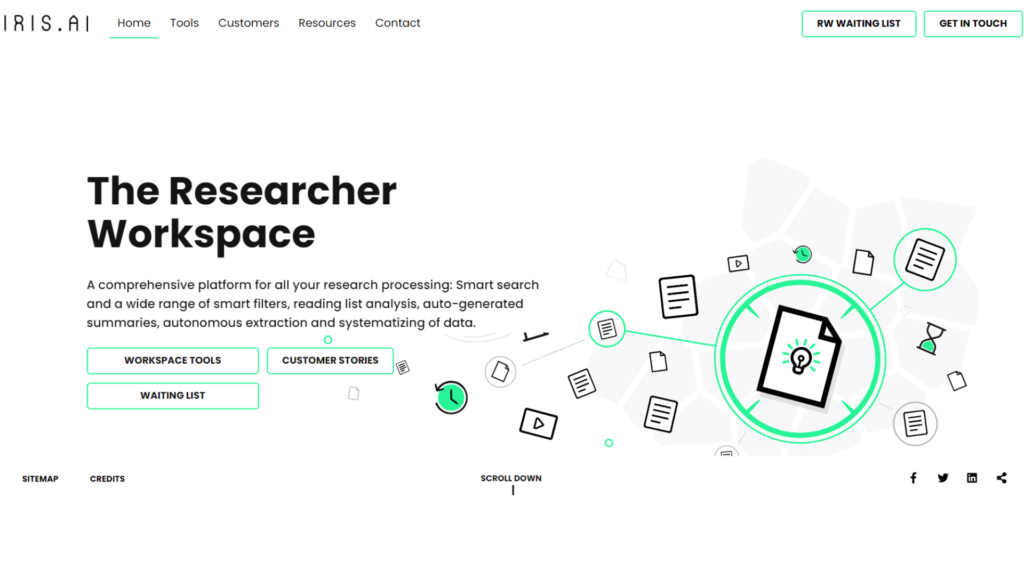
Iris.ai is an artificial intelligence solution engineered to transform the way students and researchers deal with large amounts of scientific text.
Thanks to the highly effective algorithms of natural language processing, Iris.ai is capable of comprehensive understanding of complicated research questions and locating effectively the relevant papers in the extremely wide diversity of different fields.
Being able to analyze and summarize scientific text and find matches well beyond simple keywords, the tool thus allows its users to extract the most important information elements and interdisciplinary associations they were unaware of.
Iris.ai research landscape mapping is somewhat worthwhile and, in its own way, is a bit unusual, trying, by visual means, to comprehend relationships. It could be the best fit as an AI for students assignment.
Key Features:
- Semantic search
- Automated literature review
- Visual mapping of research landscapes
- Customizable research filters
- Saves time within literature searches
- Helps discover unexpected connections
- Improves research efficiency
Website: https://iris.ai
2. Elicit

Elicit is a very new AI research assistant that leverages the most recent advances in language models when it comes to transforming users’ interaction with scientific research.
This revolutionary tool does not work as a simple search tool only but rather answers concrete research questions based on large document databases with scientific papers.
Elicit is powerful not only in the ability to locate relevant papers but also in the extraction and synthesis of key information from studies, making it a very useful tool for literature reviews.
Researchers will have a good bird’s eye view of the field interested in as the tool can compare studies and point out similarities and differences among research methodologies and findings.
Key Features:
- Enables question-answering based on research papers
- Summarizing papers automatically
- Comparative study of different studies
- Extraction of citations from the papers
- It has a user-friendly front-end
- A useful tool to prepare rapid literature overviews across diverse research areas.
Website: https://elicit.org
3. Scholarcy
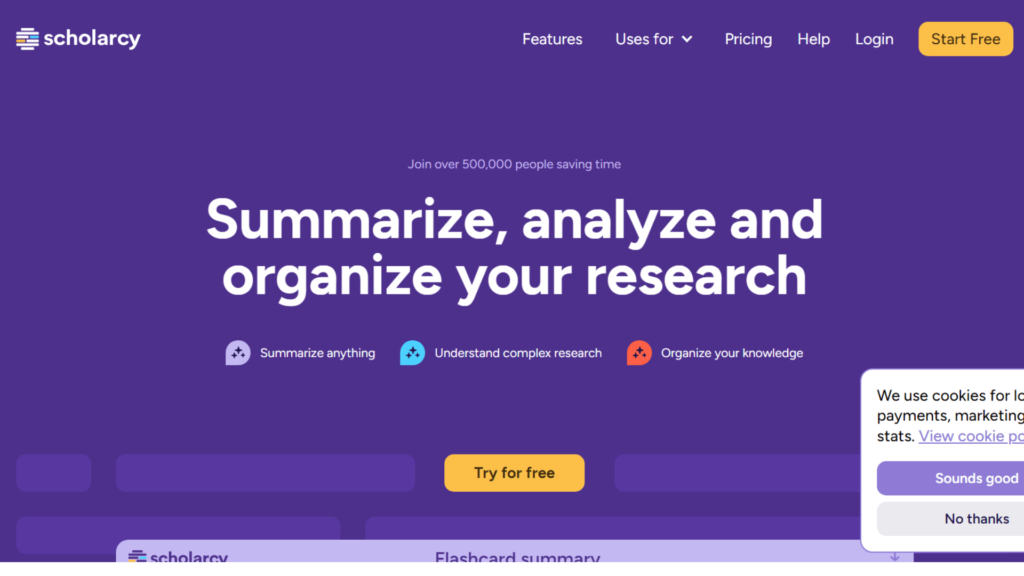
Scholarcy is an AI-driven academic document summarizer that solves the information overload problem in academic research.
For both students and researchers, Scholarcy uses state-of-the-art natural language processing to break down lengthy papers.
Features advance further by providing clear, easy-to-understand, structure-oriented summaries, with the in-extraction of crucial elements such as research purposes, methodologies, findings, and conclusions.
Key Features:
- Automatic summarization
- Reference management
- Flashcard generation
- It saves a bit of the reading and understanding time
- Perfect for students and general researchers
Website: https://www.scholarcy.com
4. Semantic Scholar

Semantic Scholar is a significant AI research tool that has pioneered research aids. It offers an extensive platform to find and understand scientific literature.
The power of Semantic Scholar is when it goes beyond mere keyword matching, understanding the meaning and significance of the findings of research.
In addition, the developed citation analysis tool of the system reveals the context surrounding each paper’s influence, alongside the level of impact therein.
The author profiles also provide a cross-indication and informative insight to users regarding an author’s general impact and work, which facilitates impromptu or spontaneity in fostering the best fit for collaboration and mentor relationships.
Key Features:
- AI-powered paper recommendations
- Citation context and influence analysis
- Author profiles and research impact metrics
- Visual paper exploration tools
- It is free of charge
- Also covering a large number of scientific disciplines
- It helps one identify influential papers and authors
Website: www.semanticscholar.org
5. SciSpace
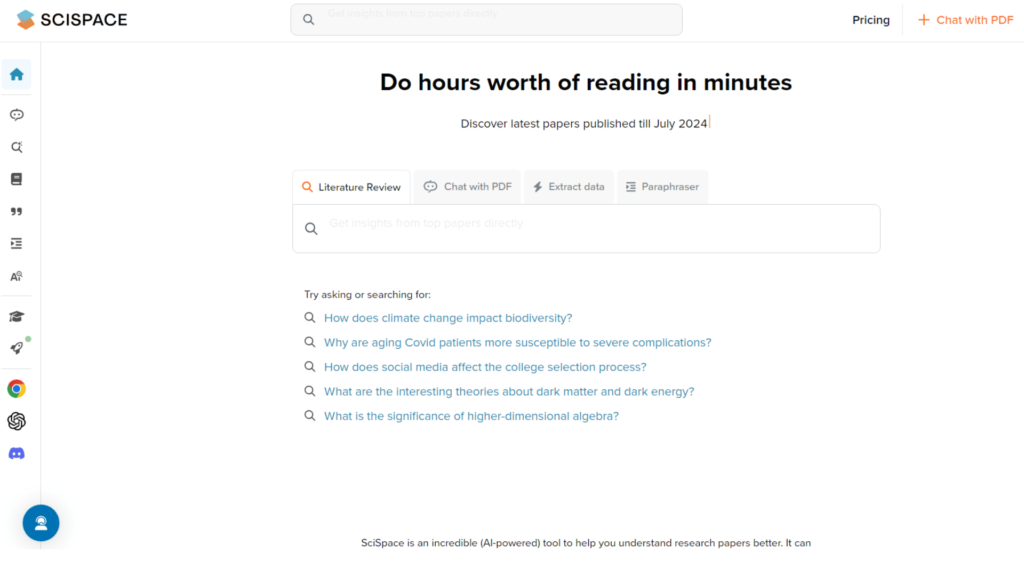
It is a collective, comprehensive approach to the research workflow now known as SciSpace, with which AI is implemented from discovery to writing and collaboration.
It has powerful natural language processing technology that complements traditional literature searches, making it easier for users to find more relevant research more quickly and accurately.
The automated summary feature can reduce the time needed to grasp important concepts by summarizing complex studies into concise readable formats.
Key Features:
- AI-powered Literature Search
- Automated Paper Summaries
- Collaborative Writing and Editing Tools Reference Management
- All-in-one solution for research workflow
- It supports the collaboration of researchers
- It amalgamates discovery and writing tools.
Website: https://typeset.io
II) AI Writing and Editing Tools
6. Grammarly
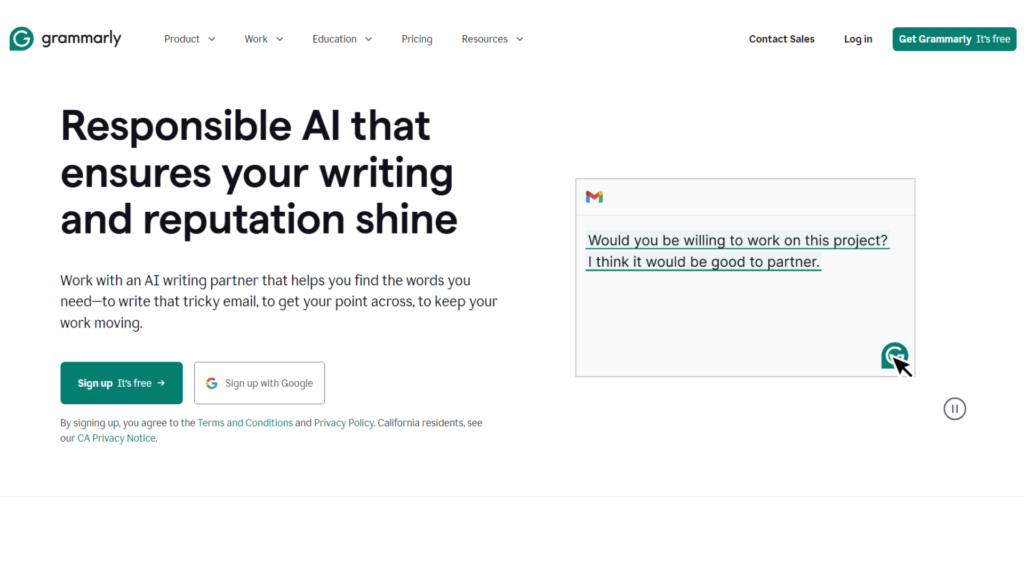
It is considered as one of the best free AI tool for education in India. Grammarly is a pioneer in the transformation of any service related to writing assistance through the application of AI.
It is a fully integrated suite of tools to assist in the betterment of the written work. Basic spell-checking is more than extended by Grammarly’s functionality; advanced natural language processing algorithms take the process to an entirely more sophisticated level, with instant grammar, punctuation, and style checking.
In-context feedback provided by Grammarly reveals an excellent understanding of the appropriate language’s clarity, engagement, and tone enhancement subtlety. For students it is the best ai assignment generator.
Key Features:
- Real-time grammar and spell-checking
- Recommendations for style and tone
- Plagiarism checks
- Adjusts word choices
- Multi-platform and user-friendly
- Learning from writing–
- Explanations for recommendations
Website: https://www.grammarly.com/
7. QuillBot
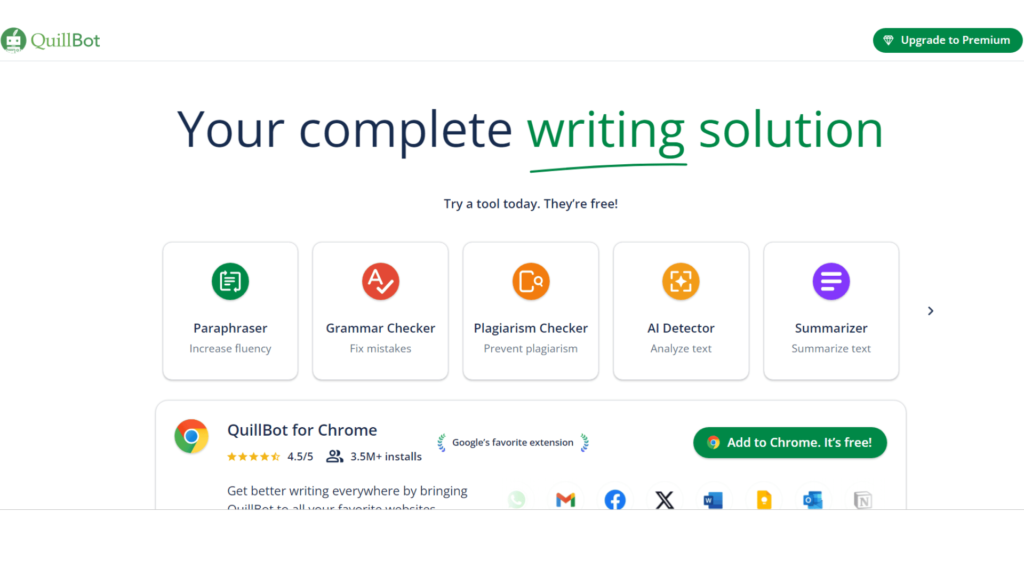
QuillBot is an AI writing tool that particularly focuses on the waylies of paraphrasing, rephrasing, and summarizing text.
At the heart of Quillbot, there is a powerful application of state-of-the-art language replication models for alternative phrasings, thereby maintaining the meaning of the input text with, of course, many stylistic choices.
The tool’s summarization functionality reduces lengthy passages to brief yet coherent summary, helping the consumption of voluminous content in a matter of seconds
Key Features:
- Multi-paraphrasing modes
- Summarization
- Grammar checker
- Citation generator
- Improves writing variety
- Great for reading complex texts
- The free version has basic features
Website: https://quillbot.com
8. Writesonic
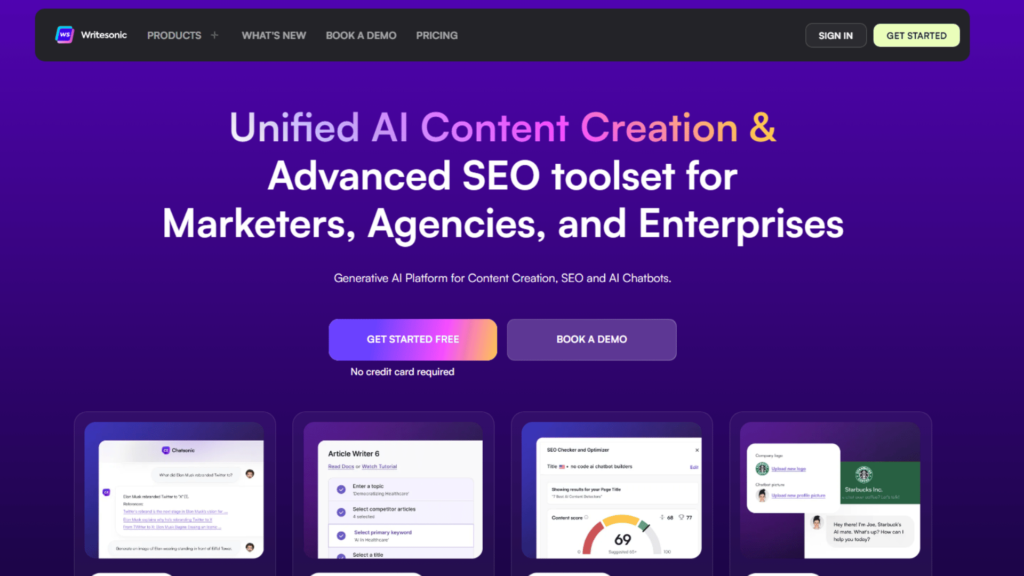
Writesonic is the next generation of AI-powered content creation. It is a powerhouse platform that helps deliver human-like text for almost any use and in any style.
Using state-of-the-art new age language models created by gargantuan datasets, Writesonic can create Anything from academic essays and articles to creative pieces and social media posts now.
It can be very useful for students, researchers, and even educators when writer’s block kicks in during a discussion or when fresh ideas are needed. Its simple yet intuitive interface allows for customizing any content to give the desired results the way the user wants and sounds.
Key Features:
- AI-powered content generation
- Different types of content generation and templates
- Readability in optimization
- Plagiarism checker
- Quite a vivid illustration
- Ideation.
- Multilanguage
Website link: https://writesonic.com
9. ProWritingAid

ProWritingAid is an overall writing assistant and not just the basic grammar and checking of spelling kind of tool.
The heart of ProWritingAid depends on deploying more evolved algorithms that give the writer a contextual analysis of text on measurable scales of.
What makes this tool outshine the others in its class is that it provides really useful, detailed, actionable feedback that doesn’t just correct an immediate problem but helps to build the writing skills of its users over time.
The platform generates full-fledged reports on the various attributes of the writing, such as the variety in sentence structures, vocabulary use, and even pacing, to give an analysis similar to what human editors would.
Key Features:
- Writing reports
- Style and Grammar Suggestions
- Integrations with multi-platforms
- Customizable to individual writing styles
- Writing goal setting and tracking
- Comprehensive feedback on writing
- Helps develop long-term writing skills
Website: https://prowritingaid.com
10. Hemingway Editor
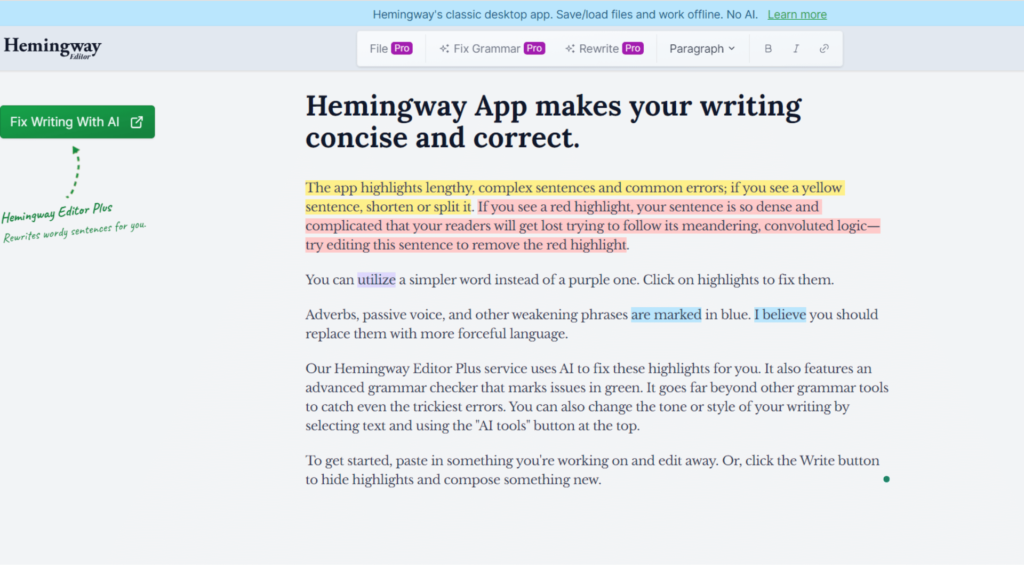
While not strictly AI-powered in the traditional sense, the Hemingway Editor uses intelligent algorithms to analyze and improve clarity and conciseness of writing.
It takes its name from Ernest Hemingway, who was believed to be a writer with clear and powerful prose, embodying the principle that good writing should be bold and clear.
The Hemingway Editor is excellent at recognizing things like complex sentences, usage of passive voice, and other forces that make reading not so readily readable.
It uses a color-coding system to highlight which areas in the body of text need improvements, thus giving immediate visual feedback to all users.
Key Features:
- Readability analysis
- Suggestions for sentence structure with color coding
- The application can catch the use of adverbs and passive voice in the writing.
- Estimation of the reading time.
- It ensures clear and concise writing with the application.
- Easy-to-use interface.
- Free web version.
Website: https://hemingwayapp.com
III) AI Tools for Time Management and Productivity
11. Notion AI
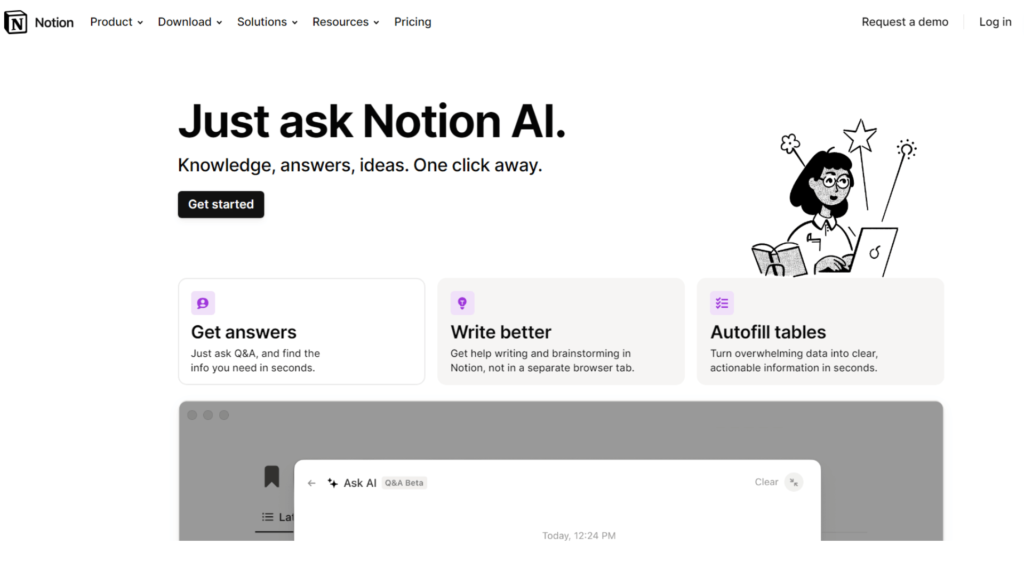
It is another AI education tool. Massive evolution notched in the workspace management by it through easily incorporating Artificial Intelligence in the much-groomed Notion platform.
This advanced tool goes beyond the basics of note-taking and project management, which will be easily changed in a way the information will be organized among students and educators.
Notion AI is capable of performing content generation, as well as summarizing existing notes, and also showing structured to-do lists out of a user’s workspace.
Key Features:
- Content Generation/Summarization with AI
- Smart Task List
- Smart database management
- Intelligent collaborative workspace boosted by Ai
- Powerful integration with pre-existing Notion workspaces
- Boosted productivity with any type of academic task
- AI-driven collaborative workspace powered by AI Features
Website: https://www.notion.so/product/ai
12. Todoist

Predominantly classed as a task management software, Todoist crosses the boundary by incorporating AI functionalities, thereby highly enhancing productivity. The app’s AI-based Smart Schedule feature is the next level of task planning.
It employs machine learning algorithms to study user behavior, task urgency, and workload patterns to suggest better times to complete a task.
This smart planning helps users set the plans that are more realistic and achievable, which is highly essential for a student with a lot of work and deadlines to manage.
The Natural Language Input feature enables planning tasks at a very fast rate, and it can even understand the context of the task for assigning a due date and priority.
Key Features:
- AI-powered task planning
- Natural language input to create tasks quickly
- Grouping tasks into projects and subtasks
- Functionalities for working together on group projects
- Available on multiple platforms with an intuitive interface
- AI scheduling for optimal time management –
- While requiring pro subscriptions for advanced features, the free version is flexible to use
Website: https://todoist.com
13. RescueTime
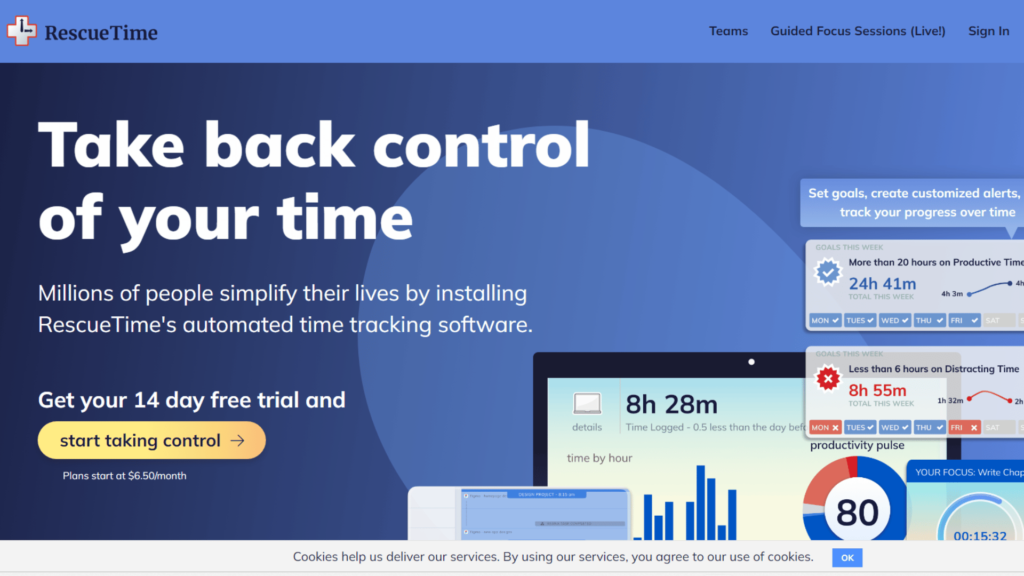
RescueTime is one of the time management apps that is uniquely designed with automatic tracking technology, tapping, and making use of AI to present users, an in-depth understanding of their digital behavior.
It works in the background, quietly logging what you do, then reports very accurately the time spent on applications and websites.
RescueTime’s AI algorithms make the categorization of activities, distinguishing which can be productive works and which can be potential distractions.
This categorization—learned automatic categorization of activities—makes it possible for a level of detailed analysis of time to be done, which could not be done in any practical way.
Key Features:
- Automatic tracking of the activities and categorizing of them
- Scoring of productivity
- Comprehensive reports and insights
- Alerts of activities and highlights
- Provides objective information on how time is spent
- Enables one to uncover and discard wasteful habits
- Runs in the background with no need for manual source entry
Website: https://www.rescuetime.com/
14. Forest
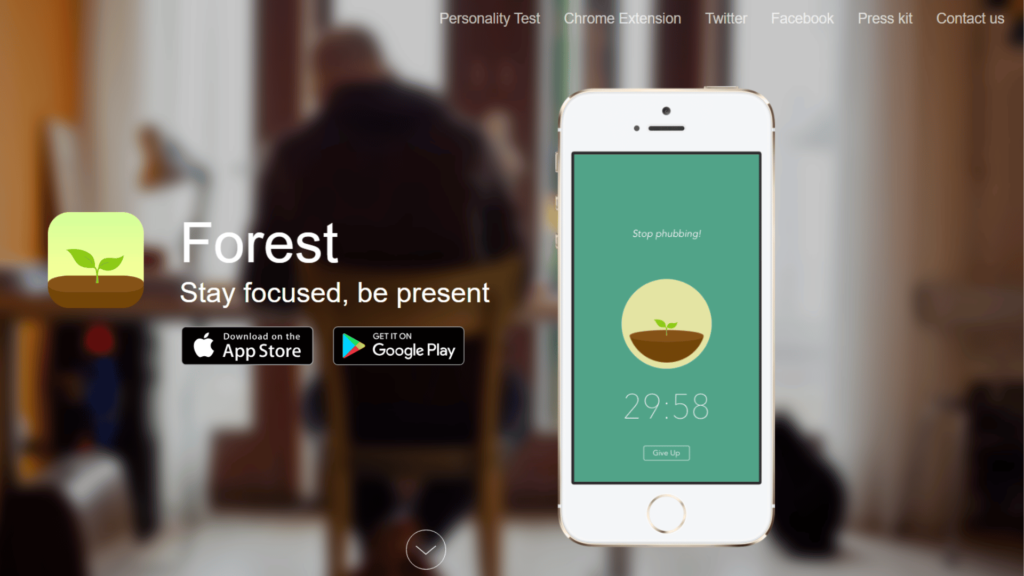
Though not AI in the classic sense of AI, it uses intelligent algorithms to record focus sessions and eventually gives individual insights out of it.
The main concept of the app is to plant virtual trees that grow throughout previously scheduled focus periods.
If users leave the application before the time they have set for checking their phone lapses, the tree dies, giving an immensely visual reason to stay on task.
In the long run, users develop a virtual forest that represents their productive time, giving a very comprehensive and motivating representation of their focus habits.
Key Features:
- Gamified focus sessions
- Customizable focus duration
- Statistics featuring insights based on productivity levels
- Share the focus with others and save the world by planting trees.
- Timekeeping becomes fun and easy
- Helps to build improved focus habits over time
- You can plant real trees through the app
Website: https://www.forestapp.cc/
15. Focus@Will

The science behind Focus@Will is the fact that there is music that can increase cognitive performance by reducing disruptions and promoting the in-the-zone experience.
Its AI keeps learning and keeps bettering the selection in music for an optimized session based on feedback and session data from the user.
It represents a powerful test aid for students and tutors during session preparation and other mentally demanding activities.
Key Features:
- Specially curated channels for productive focus
- Personalized focus mode
- Session tracking and productivity metrics.
- Cross-platform integration with other productivity tools
- Scientifically generated to boost users’ focus
- Adapts to your preferences over time
- In some users, it may greatly boost concentration
Website: https://www.focusatwill.com
Challenges and Considerations
- Ethical Concerns: Privacy, bias, and data security issues.
- Cost: Financial implications for institutions.
- Teacher Training: Ensuring educators are equipped to use AI tools effectively.
- Dependency: Avoiding over-reliance on technology.
Conclusion
With the employment of AI tools for education, a completely new epoch of the process of acquiring knowledge has opened for students, researchers, and educators.
Such tools are building a more effective, more productive, and thus more fruitful opportunity for the user in various fields of academic life. Be that advanced research aids like Iris.ai and Elicit or more extensive writing helpers such as Grammarly and ProWritingAid, the tools are making gigantic steps.
These Top 15 Ai Tools for Education will definitely help students in the sphere of education.
FAQs
1. Can these AI tools be used at any level of education?
You can use most of these tools for usage from high school through to embarking on postgraduate research.
2. Do I need technical skills to use these AI tools?
Although some of them have learning curves, most tools have specially designed interfaces such that anybody can use them without resorting to involving the technical details.
3. Can AI tools like Writesonic, QuillBot and like nature replace human writing?
These aforementioned tools should only be considered as executing and refining the human writing activity.
4. Does the use of AI in education threaten privacy?
Privacy may be a pressing concern, especially when the analyzed information involves personal data or writing.



